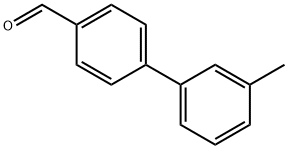4-(3-METHYLPHENYL)BENZALDEHYDE

|
- ₹0
- Product name: 4-(3-METHYLPHENYL)BENZALDEHYDE
- CAS: 400744-83-4
- MF: C14H12O
- MW: 196.24
- EINECS:
- MDL Number:MFCD03424618
- Synonyms:[1,1'-BIPHENYL]-4-CARBOXALDEHYDE, 3'-METHYL-;AKOS BAR-0057;3'-METHYL[1,1'-BIPHENYL]-4-CARBALDEHYDE;3'-METHYL [1,1'-BIPHENYL]-4-CARBOXALDEHYDE;3'-METHYLBIPHENYL-4-CARBALDEHYDE;3'-METHYL-BIPHENYL-4-CARBOXALDEHYDE;4-(3-METHYLPHENYL)BENZALDEHYDE;4-(3-Tolyl)benzaldehyde
| Manufacturer | Product number | Product description | Packaging | Price | Updated | Buy |
|---|
Properties
Melting point :45-49℃
Boiling point :332.9±21.0 °C(Predicted)
Density :1.074±0.06 g/cm3(Predicted)
Flash point :>110°(230°F)
storage temp. :under inert gas (nitrogen or Argon) at 2-8°C
Sensitive :Air Sensitive
CAS DataBase Reference :400744-83-4(CAS DataBase Reference)
Boiling point :332.9±21.0 °C(Predicted)
Density :1.074±0.06 g/cm3(Predicted)
Flash point :>110°(230°F)
storage temp. :under inert gas (nitrogen or Argon) at 2-8°C
Sensitive :Air Sensitive
CAS DataBase Reference :400744-83-4(CAS DataBase Reference)
Safety Information
| Symbol(GHS): |

|
||||||||||||||||||||||||||||
|---|---|---|---|---|---|---|---|---|---|---|---|---|---|---|---|---|---|---|---|---|---|---|---|---|---|---|---|---|---|
| Signal word: | Warning | ||||||||||||||||||||||||||||
| Hazard statements: |
|
||||||||||||||||||||||||||||
| Precautionary statements: |
|
Description
4-Formyl-3''-methyl-1,1''-biphenyl acts as a reagent in the preparation of cyclodextrin-supported palladium complex that efficiently catalysis Suzuki-Miyaura cross coupling reactions.More related product prices
2420-87-3 3,3',4,4'-Biphenyltetracarboxylic acid 36393-42-7 3-(3-METHYLPHENYL)BENZALDEHYDE 2'-METHYL-BIPHENYL-4-CARBALDEHYDE 116470-54-3Related product price
- 2420-87-3
₹4189.28-15500 - 36393-42-7
₹3800-9578 - 116470-54-3
₹4763-13661.15






